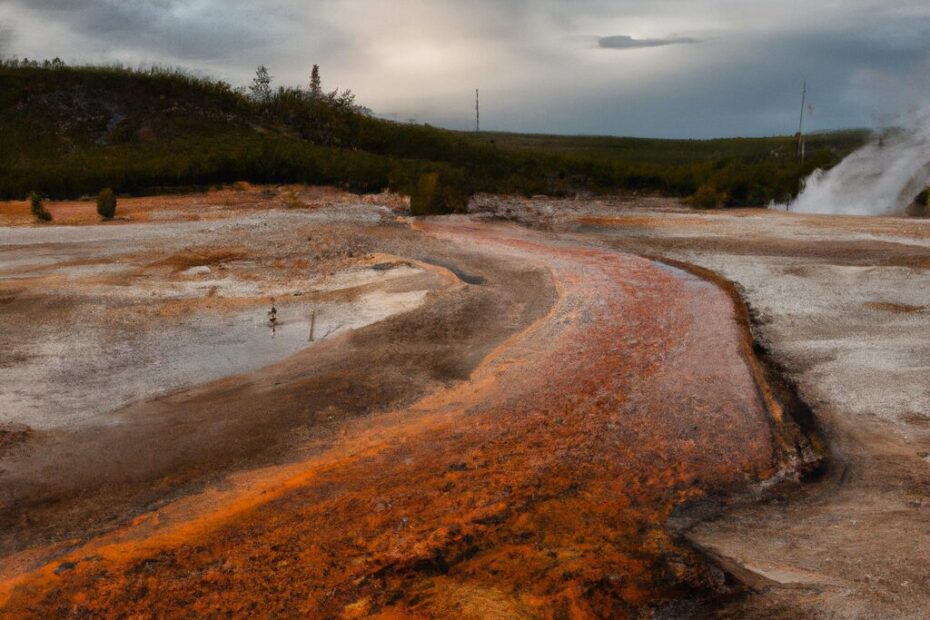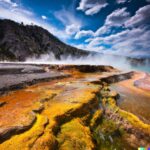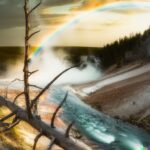Yellowstone National Park, renowned for its stunning landscapes and diverse wildlife, is also home to a hidden geological wonder – a volcano. But what exactly is a volcano, and what are the signs that one may be lurking beneath the surface?
In this article, we’ll explore the Yellowstone Caldera, geysers, and hot springs that hint at the volcanic activity below. We’ll also delve into the history of volcanic eruptions in the park, the potential risks they pose, and the safety measures in place.
So, is there a possibility of a volcanic eruption in Yellowstone National Park in the future? Let’s find out.
What Is Yellowstone National Park?
Yellowstone National Park, located primarily in the U.S. state of Wyoming, is renowned for its captivating blend of geothermal features, including the iconic Old Faithful geyser, showcasing a unique landscape shaped by volcanic activity over its extensive geological history.
The park’s geothermal wonders attract visitors from around the globe, offering a glimpse into the Earth’s powerful forces at work beneath the surface. As one explores the park’s geysers, hot springs, and mud pots, it becomes evident that Yellowstone is a living showcase of volcanic origins and ongoing geological evolution. The vibrant colors created by minerals in the hot waters, the bubbling mud pots, and the hissing geysers all contribute to the park’s mystique, reminding us of the dynamic nature of our planet’s geothermal activity.
What Is A Volcano?
A volcano is a geological formation that results from the accumulation of magma in a chamber beneath the Earth’s surface, leading to periodic eruptions that expel molten lava, ash, and volcanic rocks due to intense tectonic activity.
These magma chambers, found deep below the Earth’s crust, act as reservoirs for molten rock. As pressure builds within these chambers from the heat generated in the Earth’s mantle, the magma seeks pathways to the surface, often following fault lines or weak points in the crust.
When the pressure becomes too intense, it triggers a volcanic eruption, forcing the magma, gases, and ash to escape through vents in the volcano. The eruptions can vary in intensity, from gentle lava flows to explosive blasts that release immense energy.
What Are The Signs Of A Volcano?
Signs of an impending volcanic activity often manifest through increased seismic activity, volcanic tremors, heightened geothermal activity, and the release of volcanic gases, serving as crucial indicators of potential volcanic unrest.
Seismic events play a vital role in pinpointing the movement of magma beneath the Earth’s surface, with tremors signaling the shift and pressure build-up within volcanic systems. Geothermal anomalies, such as changes in temperature and groundwater chemistry, provide further insights into the subsurface conditions. Gas emissions, like sulfur dioxide and carbon dioxide, indicate the rising magma’s proximity to the surface. Understanding these precursory signs allows scientists to monitor and assess the potential risks associated with volcanic eruptions, enabling timely response and safety measures for at-risk populations.
Is There A Volcano In Yellowstone National Park?
Yellowstone National Park is home to a significant volcanic feature known as the Yellowstone Caldera, a massive supervolcano that underlies the park’s geothermal activity and contributes to its unique landscape.
This caldera, which has had multiple supereruptions in the past, is one of the largest active volcanic systems in the world. Its presence not only shapes the park’s physical features but also fuels the iconic geysers, hot springs, and mud pots that draw millions of visitors each year. The geothermal phenomena within Yellowstone are a testament to the powerful forces brewing beneath the Earth’s surface.
Understanding the volcanic history of Yellowstone provides insights into the potential risks and benefits associated with its geologic activity.
Yellowstone Caldera
The Yellowstone Caldera, a vast volcanic depression beneath Yellowstone National Park, harbors a complex network of interconnected magma chambers that fuel geothermal activity, sustaining a diverse ecosystem shaped by the region’s volcanic history.
These magma reservoirs play a crucial role in driving the volcanic activity patterns observed in the area. The interactions between the magma chambers and the Earth’s crust give rise to the unique geothermal features, such as geysers and hot springs, that define Yellowstone’s landscape. The Caldera’s volcanic history, marked by both explosive and effusive eruptions, has sculpted the terrain and significantly influenced the geothermal ecosystem within the park.
Understanding the dynamics of these magma chambers is essential for monitoring potential volcanic hazards and preserving the delicate balance of this geologically active region.
Geysers and Hot Springs
Yellowstone National Park boasts a mesmerizing array of geysers and hot springs, concentrated in unique geyser basins that showcase the park’s abundant geothermal resources and vibrant thermal features.
Wandering through these geyser basins, visitors are enveloped in a surreal landscape where colorful mineral deposits contrast with the steam rising from the earth. The iconic Old Faithful, a symbol of Yellowstone’s geothermal wonders, erupts with remarkable predictability, drawing crowds to witness nature’s spectacle.
As you explore further, discover lesser-known gems like the Grand Prismatic Spring, with its vivid hues that seem to defy reality. The preservation of these thermal features is paramount, reminding us of the delicate balance between human interaction and the conservation of these natural wonders.
Earthquake Activity
The region surrounding Yellowstone National Park experiences periodic earthquake swarms and volcanic tremors, indicative of underlying tectonic activity and seismic disturbances that contribute to the park’s volcanic environment.
These seismic events are closely tied to the geological processes that have shaped the landscape over millions of years. Tectonic interactions between the North American Plate and the Yellowstone Hotspot are responsible for the heightened seismic activity in the area. The movement of these tectonic plates creates stress and strain in the Earth’s crust, leading to the release of energy in the form of earthquakes and tremors. These seismic events are an integral part of the dynamic geology of Yellowstone and play a crucial role in understanding the volcanic potential of the region.
What Is The History Of Volcanic Activity In Yellowstone National Park?
The history of volcanic activity in Yellowstone National Park is a testament to its turbulent geological past, marked by numerous volcanic eruptions that have sculpted the park’s unique geology through the deposition of volcanic rocks and diverse geological formations.
These volcanic events have played a crucial role in shaping Yellowstone’s landscape over millions of years. From the massive explosion of the Lava Creek Tuff around 640,000 years ago to the powerful eruptions that formed the calderas of the park, each volcanic event has left its mark on the region. The geysers, hot springs, and fumaroles that dot the park are constant reminders of the underlying volcanic activity. The varied colors and textures of the volcanic rocks found in Yellowstone tell a story of intense heat and pressure that created them.
What Are The Potential Risks Of A Volcano In Yellowstone National Park?
The presence of a volcano in Yellowstone National Park poses several potential risks, including volcanic hazards such as ashfall, lahars, and pyroclastic flows that could impact the park and its surrounding areas in the event of a volcanic eruption.
Ashfall, for instance, can blanket wide areas with thick layers of volcanic ash, disrupting ecosystems and posing respiratory health risks for both wildlife and humans.
Lahars, fast-moving mudflows triggered by volcanic activity, have the potential to devastate river valleys and infrastructure downstream from the park.
Pyroclastic flows, high-speed avalanches of hot ash, gas, and volcanic rock, can travel great distances, posing immediate danger to anything in their path.
Understanding and assessing these volcanic risks is crucial for effective hazard mitigation strategies in the region.
Ashfall
Ashfall resulting from volcanic eruptions in Yellowstone National Park can have far-reaching effects, impacting air quality, vegetation, and local communities due to the pervasive nature of volcanic ash and its associated hazards.
The consequences of ashfall are significant, with the environmental impacts including the smothering of vegetation, contamination of water sources, and disruption of ecosystems. Societally, ashfall can pose health risks, especially for those with respiratory conditions, and can lead to economic losses for agriculture and tourism sectors in affected areas. The aftermath of volcanic ash deposition may also result in transportation disruptions, infrastructure damage, and long-term soil degradation, emphasizing the broader implications of volcanic hazards for both natural environments and human populations.
Lahars
Lahars, volcanic debris flows triggered by volcanic activity, pose a significant hazard in Yellowstone National Park, necessitating thorough volcanic risk assessment and mitigation strategies to safeguard against the destructive potential of these geological phenomena.
These fast-moving flows of mud, rocks, and water can travel at high speeds and have the ability to completely engulf and destroy anything in their path. The unique topography of Yellowstone National Park, with its steep slopes and hydrothermal features, creates conditions conducive to lahar formation.
Recognizing the risks associated with lahars, experts emphasize the importance of early detection and warning systems to alert nearby communities and visitors. Implementing effective mitigation measures, such as constructing barriers or diversion channels, can help minimize the impacts of lahars and protect lives and infrastructure.
Pyroclastic Flows
Pyroclastic flows, fast-moving avalanches of hot volcanic gases and debris, represent a formidable volcanic hazard in Yellowstone National Park, requiring meticulous volcanic risk assessment and preparation due to the unpredictable nature of these destructive phenomena.
They are charged with high temperatures, traveling at incredible speeds that can reach hundreds of kilometers per hour, making their impact swift and devastating.
The ability to predict the occurrence of pyroclastic flows relies heavily on advanced volcanic risk assessment tools, including monitoring eruptive activity and understanding eruption probabilities.
Preparation efforts involve establishing evacuation plans, emergency response protocols, and public awareness campaigns to educate people on the dangers posed by these lethal volcanic events.
How Is The Volcano Activity In Yellowstone National Park Monitored?
Volcanic activity in Yellowstone National Park is closely monitored through a sophisticated volcanic monitoring system that tracks seismic activity, geothermal anomalies, and other indicators of potential volcanic unrest to ensure timely responses and hazard mitigation.
Seismic detection plays a crucial role in this monitoring process as it can detect the slightest ground movements that could indicate volcanic activity. Geothermal exploration helps in understanding the heat sources beneath the surface and anticipates potential eruptions. The utilization of advanced systems for volcanic hazard management enhances the efficiency of monitoring efforts, providing early warnings and allowing authorities to take necessary precautions to protect both visitors and the park’s ecosystem.
What Are The Safety Measures In Place For A Volcano In Yellowstone National Park?
Comprehensive safety measures exist for managing volcanic risks in Yellowstone National Park, encompassing detailed volcanic response plans, geothermal safety protocols, and robust hazard mitigation strategies to protect visitors and wildlife from potential volcanic impacts.
These safety protocols include regular monitoring of geothermal activity to provide early warning signals, evacuation procedures to swiftly move people out of high-risk areas in case of escalating volcanic activity, and coordination with local authorities for efficient emergency response. Public education campaigns are conducted to raise awareness about volcanic hazards and what to do in case of an eruption. By prioritizing geothermal safety measures and having well-defined volcanic response planning, Yellowstone aims to minimize the risks associated with its unique geological features.
Is There A Possibility Of A Volcanic Eruption In Yellowstone National Park In The Future?
While the likelihood of a volcanic eruption in Yellowstone National Park remains uncertain, ongoing scientific predictions, volcanic activity statistics, and emergency response plans are crucial for anticipating and preparing for potential volcanic events in the future.
One of the key elements in predicting volcanic eruptions in Yellowstone is the use of advanced technology and monitoring systems to detect any changes in the park’s geothermal features. By analyzing historical data and seismic activity, scientists can create predictive models that help estimate the probability of an eruption. These predictive models play a vital role in informing emergency preparedness strategies and evacuation plans. Ongoing research and collaboration among geologists, seismologists, and emergency management agencies contribute to enhancing our understanding of volcanic behavior and improving response preparedness.
Current Activity
The current volcanic activity in Yellowstone National Park revolves around the dynamic Yellowstone hotspot, driving the emergence of volcanic vents and sustaining essential geothermal resources that contribute to conservation efforts and provide various benefits to the ecosystem.
These volcanic vents, formed through ongoing geological processes, are vital conduits for the release of heat and gases from deep within the Earth. Geothermal conservation practices utilize this natural energy to power facilities and reduce reliance on non-renewable resources, thereby promoting sustainability within the park. The positive impacts of geothermal benefits on the ecosystem are manifold, from supporting unique microbial communities in hot springs to maintaining the balance of thermal habitats for diverse plant and animal species.
Scientific Predictions
Scientific predictions regarding future volcanic events in Yellowstone National Park rely on historical volcanic timelines, eruption prediction models, ongoing geothermal projects, and advancements in geothermal technology to enhance monitoring capabilities and risk assessment strategies.
By analyzing data from past eruptions, scientists can identify patterns that may indicate when the next eruption could occur in Yellowstone. These eruption prediction models utilize various factors like seismic activity, gas emissions, and ground deformation to forecast volcanic events.
Geothermal initiatives play a crucial role in this process, as they provide valuable information about the underground thermal activity that could influence volcanic behavior. Technological innovations such as remote sensing and satellite imagery further aid in real-time monitoring, allowing researchers to detect subtle changes in the volcanic system that may precede an eruption.
Emergency Response Plans
Comprehensive emergency response plans in Yellowstone National Park outline protocols to address potential volcanic impacts, safeguard geothermal tourism activities, and promote sustainable practices that ensure the long-term viability of geothermal resources within the park.
These plans have been meticulously developed to account for various eruption scenarios, aiming to minimize disruption to both local communities and geothermal attractions. By integrating advanced monitoring systems, authorities can closely track volcanic activity and issue timely warnings to protect visitors and residents. Efforts are in place to enhance public awareness regarding volcanic risks and the importance of adopting sustainable geothermal practices to mitigate environmental impacts and secure the park’s natural treasures for future generations.
Last Updated on February 8, 2024 by Jon Waraas – Originally Posted: February 8, 2024

I’m Jon Waraas, and I’ve been navigating the online world since 2006. By day, I’m the proud owner of some eCommerce gems, and by night, I’m the voice behind the adventures on Waraas.Com.
My heart, however, belongs to the wild beauty of Yellowstone National Park. I’ve got a collection of websites dedicated to sharing the wonders of this natural masterpiece. Oh, and did I mention? I’m currently building my own cabin inside the ghost town of Gilmore, Idaho – a cabin with tales to tell!
When I’m not immersed in the digital realm, you’ll find me lacing up my boots for a good hike or setting up camp under the star-studded sky.




